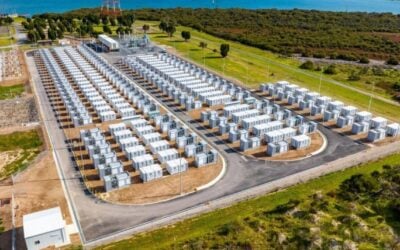
RES (Renewable Energy Systems) has confirmed the expected capacity and output of a photovoltaics-linked energy storage system being developed for a railway in Canada which will use lithium-ion batteries.
Ontario’s Ministry of Transportation announced in mid-February that local company Toronto Hydro has entered into an agreement with RES to design and build a battery energy storage facility for the Eglinton Crosstown light rail transit (LRT) line. The line is new and being built with 25 stops across the heart of Toronto, scheduled for completion by 2021.
The energy storage system will be located at the site of what is to be Mount Dennis Station, which also has maintenance and storage facilities and is being constructed at present. The energy storage system, which representatives of RES and for Toronto Hydro told Energy-Storage.News will be 10MW / 30MWh, using lithium-ion batteries.
As well as providing backup power for the LRT line, the storage system will be charged with cheaper, off-peak electricity during night-time and then use that stored power the following day during peaks in demand. This should have the combined effect of lowering operating costs and reducing emissions, while of course backing up the railway in the event of a power outage.
Try Premium for just $1
- Full premium access for the first month at only $1
- Converts to an annual rate after 30 days unless cancelled
- Cancel anytime during the trial period
Premium Benefits
- Expert industry analysis and interviews
- Digital access to PV Tech Power journal
- Exclusive event discounts
Or get the full Premium subscription right away
Or continue reading this article for free
The project comes as part of a huge investment into public services and infrastructure from the Province of Ontario. Local authorities claim the plans will see more than C$190 billion (US$150 billion) of investments, supporting as many as 125,000 jobs a year, with nearly 5,000 projects already underway.
The battery energy storage system will make savings on peak demand energy costs under Ontario’s policy, the Global Adjustment Charge. Essentially, the policy levies charges onto all electricity customers across the Province, to help pay for grid costs and modernisation, renewables and environmental costs. The Adjustment Charges are much higher for commercial and industrial (C&I) electricity ratepayers and similar to demand charges for C&I users in the US, this has driven the business case forward for C&I energy storage in Canada.
RES’ partner, Toronto Hydro, confirmed to Energy-Storage.News that the Eglinton LRT system would work along these lines.
“This project will be dispatched jointly by Toronto Hydro and (rail operator) Metrolinx to shift demand off-peak, which is expected to reduce the Global Adjustment Charge,” A representative said.
Asked what the project’s partners expect the biggest challenges to be in successful execution, Toronto Hydro referred to the logistical complexity of the system’s design and installation.
“Technical challenges are expected to include coordination on a large worksite, commissioning of complex equipment, integration with other Eglinton Crosstown LRT systems and optimising the battery storage assets for maximum life,” the representative said.
“We have assembled a capable team who will address these challenges and complete this innovative project.”
RES meanwhile confirmed that the batteries will be linked to a modest photovoltaic installation, a 90kW rooftop array on the building housing the energy storage system.
There have been other innovative energy storage systems deployed for railway use in the recent past. German flywheel manufacturer Stornetic has marketed its devices to the rail transport sector, offering fast-responding short-term storage from braking trains, while a 2016 project involving ABB and SAFT stores energy from regenerative braking with a system that could reduce energy use by 30%.
“A strong partner in the province is needed to realize the goal of making Mount Dennis the city’s first net zero neighbourhood,” local councillor Frances Nunziata said about Toronto Hydro-Ontario-RES’ project.
“The move away from a gas generator to a battery energy storage facility shows our provincial government’s commitment to helping achieve this goal. Further, it demonstrates a willingness for ongoing collaboration with the city and the local community so that together, we can make strides on neighbourhood scale climate action.”
Great turnout this morning as it was announced that the #CrosstownLRT is on its way to becoming a reality as #Ontario and #TorontoHydro have awarded the contract to design the battery energy storage facility at the future Mt. Dennis Station. #ward11 #mountdennis #crosstownTO pic.twitter.com/8JeIhk7zof
— Frances Nunziata (@FrancesNunziata) February 15, 2018





